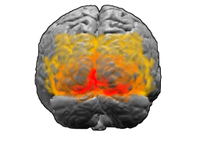
Photo from wikipedia
The early postnatal development of the A-layers of the dorsal lateral geniculate nucleus (LGNd) was investigated in kittens aged 0–34 days by immunohistochemistry for the selective marker for neuronal differentiation (NeuN… Click to show full abstract
The early postnatal development of the A-layers of the dorsal lateral geniculate nucleus (LGNd) was investigated in kittens aged 0–34 days by immunohistochemistry for the selective marker for neuronal differentiation (NeuN protein) and parvalbumin. We report two new facts about the LGNd development. First, there is a transient stratification of NeuN labelling in layer A, and to a lesser extent in layer A1, in kittens aged 0 and 4 days. Second, a transient population of large cells that are located between the LGNd A-layers (interlaminar cells) showed high expression levels of both NeuN and parvalbumin. These neurons possessed both the morphological and immunohistochemical features, similar to cells in the neighbouring perigeniculate nucleus. Both NeuN-stratification and double-stained interlaminar cells gradually disappeared during the second postnatal week, and almost completely vanished by the opening of the critical period. We discuss a possible linkage between these observed transitory networks and the ON-/OFF- and X-/Y-cells development and propose that the data obtained reflect the functioning of the early environmentally independent geniculate networks.
Journal Title: Cellular and Molecular Neurobiology
Year Published: 2018
Link to full text (if available)
Share on Social Media: Sign Up to like & get
recommendations!